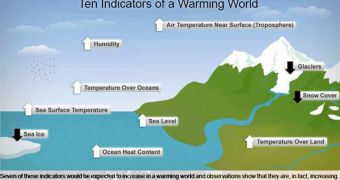The past decade was the warmest ever recorded. This is the bleak conclusion of the 2009 State of the Climate report, a document created by an international “army” of scientists and researchers. An estimated 300 experts from 48 countries participated in this investigation, organized in 160 research groups. They derived their data from 10 key climate indicators, each of which points to the same conclusion – the planet is undeniably getting warmer. The trend has been taking place for the last 50 years, the report also shows.
“For the first time, and in a single compelling comparison, the analysis brings together multiple observational records from the top of the atmosphere to the depths of the ocean. The records come from many institutions worldwide. They use data collected from diverse sources, including satellites, weather balloons, weather stations, ships, buoys and field surveys. These independently produced lines of evidence all point to the same conclusion: our planet is warming,” says NOAA Administrator, Jane Lubchenco, PhD, who is the US under secretary of commerce for oceans and atmosphere.
The ten indicators are divided into two groups. Variables in the first are on the rise. These are air temperature over land, sea-surface temperature, air temperature over oceans, sea level, ocean heat, humidity and tropospheric temperature in the “active-weather” layer of the atmosphere closest to the Earth’s surface, the report says. Variables in the second group are declining. They are Arctic sea ice, glaciers and the extent of the spring snow cover in the Northern hemisphere. The current state of each of these factors proves that we are living on a warming world.
“Despite the variability caused by short-term changes, the analysis conducted for this report illustrates why we are so confident the world is warming. When we look at air temperature and other indicators of climate, we see highs and lows in the data from year to year because of natural variability. Understanding climate change requires looking at the longer-term record. When we follow decade-to-decade trends using multiple data sets and independent analyses from around the world, we see clear and unmistakable signs of a warming world,” says the head of the United Kingdom Met Office Hadley Center (MOHC) Climate Monitoring and Attribution section, Peter Stott, PhD. He was also a contributor on the new report.
“The temperature increase of one degree Fahrenheit over the past 50 years may seem small, but it has already altered our planet. Glaciers and sea ice are melting, heavy rainfall is intensifying and heat waves are more common. And, as the new report tells us, there is now evidence that over 90 percent of warming over the past 50 years has gone into our ocean,” says the chief of the NOAA National Climatic Data Center (NCDC) Climate Monitoring Branch Deke Arndt. He is also the co-editor of the document.

 14 DAY TRIAL //
14 DAY TRIAL //